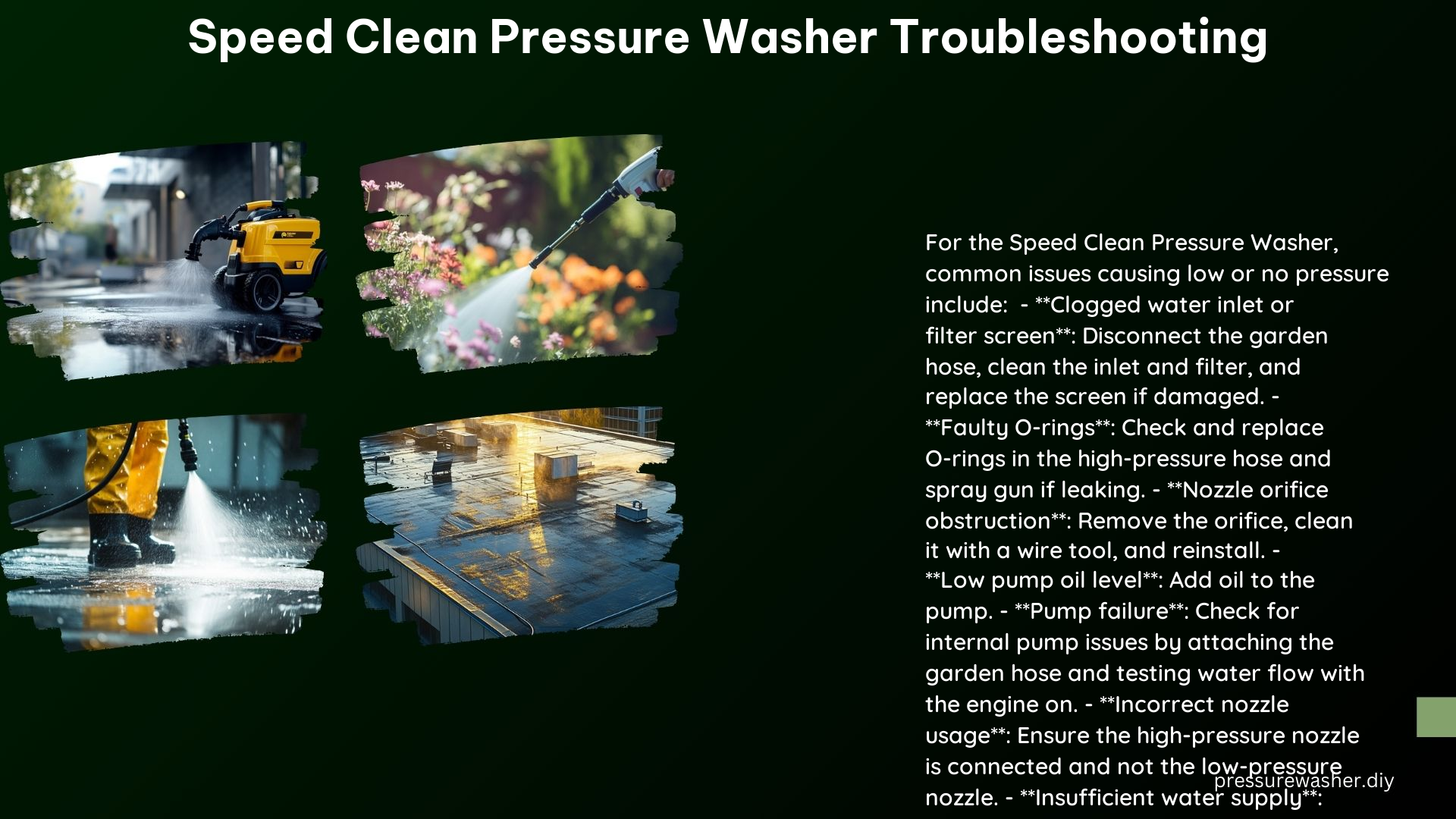As an expert on Speed Clean Pressure Washer Troubleshooting, I’m here to provide you with a comprehensive guide to address the most common issues you may encounter with your pressure washer. This guide will cover a wide range of problems, from low pressure to engine-related issues, and offer step-by-step solutions to help you get your Speed Clean pressure washer back in top working condition.
Common Issues with Speed Clean Pressure Washer
1. Low Pressure
One of the most common problems with a Speed Clean pressure washer is low pressure. This can be caused by several factors, and it’s essential to address them systematically to restore the desired pressure.
- Clogged Nozzles or Orifices: Check the nozzle and orifice for any debris or blockages. Use a 2mm Allen wrench to remove the orifice and clean it with a paperclip or a small wire. Ensure the nozzle moves freely and is not stuck.
- Dirty Water Inlet and Filter Screen: Inspect the water inlet and filter screen for any debris or buildup. Clean the filter screen by removing it and running it under a tap to dislodge any trapped particles.
- Engine Speed: Verify that the engine is running at full speed. If the engine is not running at its maximum RPM, the pressure output will be reduced.
- High-Pressure Hose Leaks: Inspect the high-pressure hose for any signs of leaks or damage. Replace the O-rings if necessary to prevent pressure loss.
2. No Water Flow
If you’re experiencing no water flow from your Speed Clean pressure washer, consider the following troubleshooting steps:
- Garden Hose Filter Clogged: Check the garden hose filter for any debris and clean or replace it if needed. A clogged filter can restrict water flow and prevent the pressure washer from operating properly.
- Inadequate Pump Oil Level: Ensure the pump oil level is at the recommended level. Low oil can cause the pump to seize and prevent water flow.
- Excessive Supply Water Temperature: Verify that the supply water temperature is below 100°F (37.8°C). Temperatures above this can cause the pressure washer to shut down or experience reduced performance.
- Clogged or Damaged Spray Tips and Nozzles: Inspect the spray tips and nozzles for any clogs or damage. Clean or replace them as necessary to restore water flow.
3. Engine Issues
If you’re experiencing problems with the engine of your Speed Clean pressure washer, consider the following troubleshooting steps:
- Low Oil Level: Check the engine oil level and add more oil if necessary. Running the engine with low oil can cause significant damage.
- Dirty Air Cleaner: Ensure the air cleaner is clean and free of any debris. A clogged air cleaner can restrict airflow and affect engine performance.
- Stale or Contaminated Fuel: If the engine is not starting or running properly, try using fresh fuel. Stale or contaminated fuel can cause issues with the engine.
Troubleshooting Low Pressure Issues

1. Check the Garden Hose Filter
The garden hose filter is a crucial component in maintaining the proper water flow and pressure for your Speed Clean pressure washer. Follow these steps to inspect and clean the filter:
- Disconnect the garden hose from the pressure washer’s water inlet.
- Remove the filter and inspect it for any debris or buildup.
- If the filter is dirty, flip it over and run it under a tap to dislodge any trapped particles.
- Reinstall the clean filter and reconnect the garden hose.
2. Inspect the High-Pressure Hose
The high-pressure hose is another critical component that can affect the pressure output of your Speed Clean pressure washer. Follow these steps to inspect the hose:
- Check the hose for any visible leaks or damage.
- Replace the O-rings if you notice any signs of wear or deterioration.
- Ensure the hose is not kinked or obstructed, as this can restrict water flow and reduce pressure.
3. Check the Nozzle and Wand
The nozzle and wand assembly can also contribute to low pressure issues. Follow these steps to inspect and clean the nozzle:
- Ensure the nozzle is not stuck and moves freely.
- Use a 2mm Allen wrench to remove the orifice from the wand.
- Clean out any debris from the orifice using a paperclip or a similar tool.
- Run water through the wand to clear out any remaining debris.
- Reinstall the orifice after cleaning.
Fixing a Clogged Nozzle
If you’re experiencing a clogged nozzle, follow these steps to clean it:
- Remove the Orifice: Use a 2mm Allen wrench to remove the orifice from the wand.
- Clean the Orifice: Clean out any debris from the orifice using a paperclip or a similar tool.
- Clean the Wand: Run water through the wand to clear out any remaining debris.
- Reinstall the Orifice: After cleaning, reinstall the orifice back into the wand.
Technical Specifications
To ensure optimal performance and troubleshoot your Speed Clean pressure washer effectively, it’s essential to understand the technical specifications of your unit:
- Engine Speed: The engine should be running at its full speed (typically around 3,400 RPM) to maintain the desired pressure output.
- Water Inlet and Filter Screen: The water inlet and filter screen should be cleaned regularly to prevent clogs and maintain a consistent water flow.
- Pump Oil Level: Maintain the recommended oil level in the pump to prevent damage and ensure proper operation.
- Supply Water Temperature: The supply water temperature should be below 100°F (37.8°C) for optimal performance.
- Supply Water Pressure and Flow Rate: Verify that the supply water meets the minimum pressure (20 PSI) and flow rate (4 GPM) requirements for your Speed Clean pressure washer model.
References
- Speed Clean 2000 Pressure Washer Repair:
-
Speed Clean Operator’s Manual:
-
https://www.manualslib.com/manual/500837/Briggs-And-Stratton-Speed-Clean.html?page=21
-
APW Repair Center: Diagnosing Low Pressure:
-
Briggs & Stratton: Pressure Washer Troubleshooting:
- https://www.briggsandstratton.com/na/en_us/support/faqs/browse/pressure-washer-produces-low-pressure.html
Remember, if you’re still experiencing issues with your Speed Clean pressure washer after following these troubleshooting steps, it’s always best to consult the manufacturer’s instructions or seek professional assistance to ensure the safety and proper operation of your equipment.
